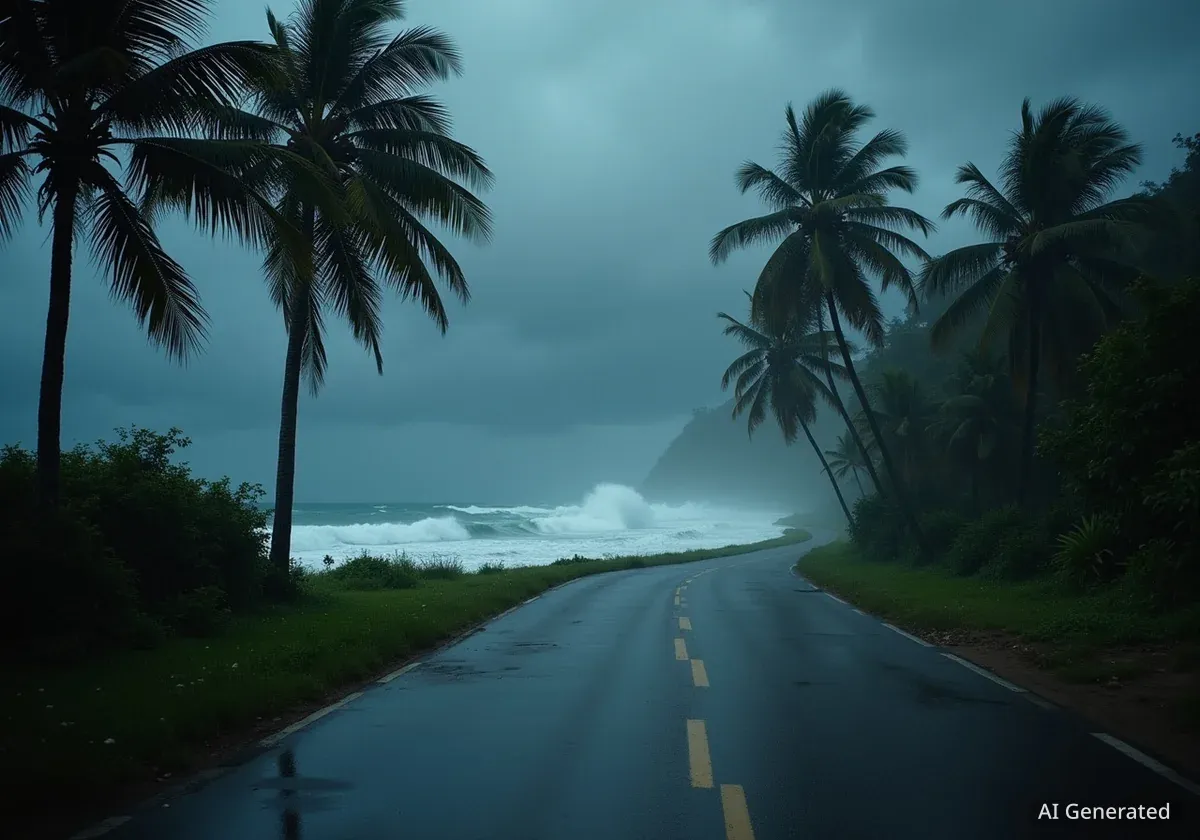Hurricane Melissa, a powerful Category 5 storm, is slowly moving toward Jamaica, threatening to become the strongest hurricane to ever make landfall on the island nation. With sustained winds reaching 175 miles per hour, officials are warning of potentially devastating and life-threatening conditions.
The storm, the 13th named storm of the Atlantic hurricane season, intensified rapidly over the open waters of the Caribbean. Its slow forward speed is a major concern for forecasters, as it increases the risk of prolonged rainfall, catastrophic flash flooding, and landslides across the mountainous terrain of Jamaica and neighboring islands.
Key Takeaways
- Hurricane Melissa has reached Category 5 status with winds of 175 mph (280 km/h).
- The storm is on a path to make landfall in Jamaica and could be the strongest in the nation's recorded history.
- Its slow movement is expected to cause severe and prolonged rainfall, leading to life-threatening flash floods and landslides.
- Advanced satellite technology from NOAA is providing critical data on the storm's structure and intensity.
A Historic Threat to the Island
Hurricane Melissa's current strength places it in a category of its own when compared to past storms that have hit Jamaica. The nation has a history of hurricanes, but a direct landfall from a Category 5 storm would be unprecedented.
According to historical data from the National Oceanic and Atmospheric Administration (NOAA), only three hurricanes have made landfall on the island since 1950. The most powerful of these were Hurricane Charlie in 1951 and Hurricane Gilbert in 1988, both of which were Category 3 storms at the time of impact.
Jamaica's Hurricane History
Since 1950, Jamaica has not experienced a direct landfall from a hurricane stronger than a Category 3. Melissa's potential impact as a Category 5 storm would set a new and dangerous record.
The intensity of Melissa presents a severe threat. Winds of this magnitude can cause catastrophic damage to buildings, infrastructure, and agriculture. The combination of high winds and saturated ground raises the risk of widespread power outages and communication disruptions that could last for weeks.
Slow-Moving Storm Amplifies Danger
One of the most dangerous characteristics of Hurricane Melissa is its slow forward progression. While a faster storm passes over an area relatively quickly, a slow-moving system like Melissa can linger for an extended period, unleashing immense amounts of rainfall on a single location.
This prolonged exposure dramatically increases the risk of several life-threatening hazards:
- Flash Flooding: Continuous heavy rain can overwhelm rivers and drainage systems, leading to rapid and dangerous flooding in low-lying areas.
- Landslides: Jamaica's mountainous interior is highly susceptible to landslides, which can be triggered by oversaturated soil from persistent rainfall.
- Structural Damage: Buildings and infrastructure are forced to endure hurricane-force winds for a longer duration, increasing the likelihood of structural failure.
After passing Jamaica, the storm is forecast to continue its slow path, bringing significant rainfall and wind to parts of the Dominican Republic and Haiti later in the week.
Advanced Satellites Provide Critical Insight
Forecasters and scientists are closely monitoring the storm's every move using a fleet of advanced weather satellites. NOAA's Geostationary Operational Environmental Satellite (GOES) network, including the GOES-19 satellite, is providing high-definition imagery and crucial data about the hurricane's development.
What Satellites See
Instruments aboard the GOES satellites can detect lightning flashes within the hurricane's powerful eyewall, pinpoint the exact moment the storm began to rapidly intensify, and map the extent of its outer rain bands. This information is vital for accurate forecasting and issuing timely warnings.
The satellite imagery has documented Melissa's journey from a developing system into a symmetrical and formidable hurricane. The data revealed how the storm organized itself over the warm Caribbean waters, gaining strength and becoming more structured. This level of detailed observation helps meteorologists refine their predictions about the storm's path and potential impact, giving authorities on the ground more time to prepare.
"Thanks to satellites in space, scientists and forecasters are able to follow the storm along its path, watching it grow in size and strength throughout its lifespan," noted one meteorological report.
As Hurricane Melissa approaches, these technological eyes in the sky will be indispensable for providing real-time updates to emergency responders and the public, tracking its final movements before it makes its potentially historic landfall.


